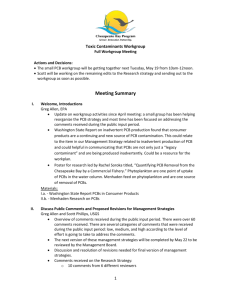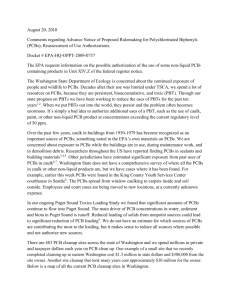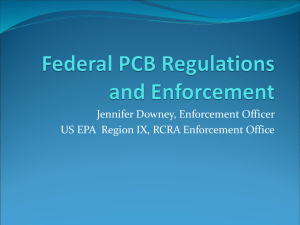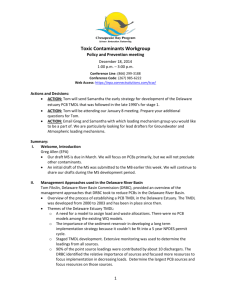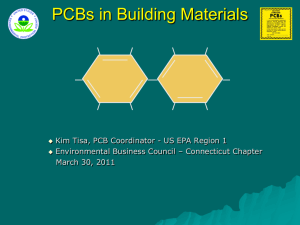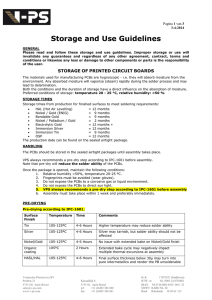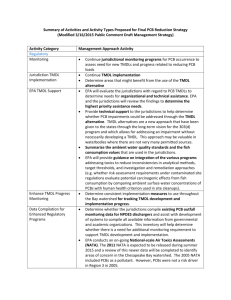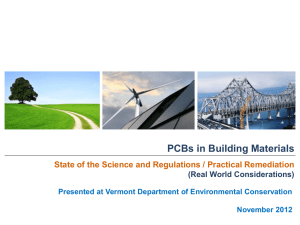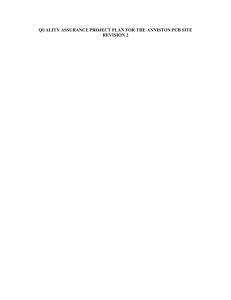View document
advertisement
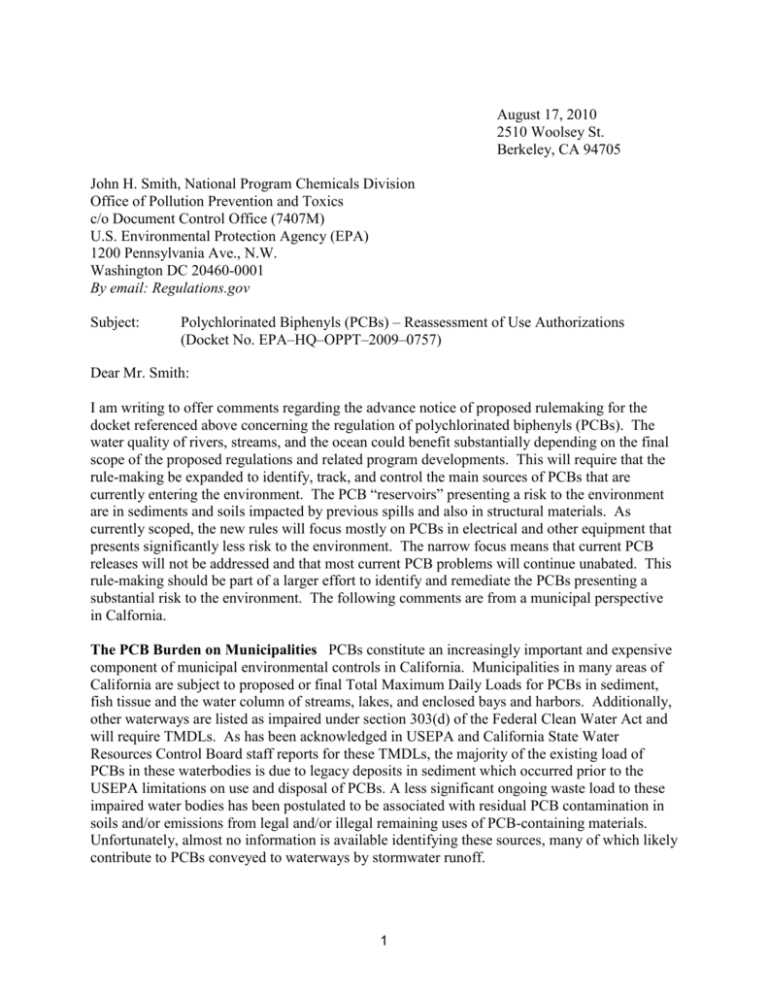
August 17, 2010 2510 Woolsey St. Berkeley, CA 94705 John H. Smith, National Program Chemicals Division Office of Pollution Prevention and Toxics c/o Document Control Office (7407M) U.S. Environmental Protection Agency (EPA) 1200 Pennsylvania Ave., N.W. Washington DC 20460-0001 By email: Regulations.gov Subject: Polychlorinated Biphenyls (PCBs) – Reassessment of Use Authorizations (Docket No. EPA–HQ–OPPT–2009–0757) Dear Mr. Smith: I am writing to offer comments regarding the advance notice of proposed rulemaking for the docket referenced above concerning the regulation of polychlorinated biphenyls (PCBs). The water quality of rivers, streams, and the ocean could benefit substantially depending on the final scope of the proposed regulations and related program developments. This will require that the rule-making be expanded to identify, track, and control the main sources of PCBs that are currently entering the environment. The PCB “reservoirs” presenting a risk to the environment are in sediments and soils impacted by previous spills and also in structural materials. As currently scoped, the new rules will focus mostly on PCBs in electrical and other equipment that presents significantly less risk to the environment. The narrow focus means that current PCB releases will not be addressed and that most current PCB problems will continue unabated. This rule-making should be part of a larger effort to identify and remediate the PCBs presenting a substantial risk to the environment. The following comments are from a municipal perspective in Calfornia. The PCB Burden on Municipalities PCBs constitute an increasingly important and expensive component of municipal environmental controls in California. Municipalities in many areas of California are subject to proposed or final Total Maximum Daily Loads for PCBs in sediment, fish tissue and the water column of streams, lakes, and enclosed bays and harbors. Additionally, other waterways are listed as impaired under section 303(d) of the Federal Clean Water Act and will require TMDLs. As has been acknowledged in USEPA and California State Water Resources Control Board staff reports for these TMDLs, the majority of the existing load of PCBs in these waterbodies is due to legacy deposits in sediment which occurred prior to the USEPA limitations on use and disposal of PCBs. A less significant ongoing waste load to these impaired water bodies has been postulated to be associated with residual PCB contamination in soils and/or emissions from legal and/or illegal remaining uses of PCB-containing materials. Unfortunately, almost no information is available identifying these sources, many of which likely contribute to PCBs conveyed to waterways by stormwater runoff. 1 Municipalities are being placed in an untenable position by the promulgation of these TMDLs as they are being held responsible for waste load allocations of trace amounts of PCBs conveyed via the municipal storm sewer system without the means to either regulate or identify the potential sources of residual PCB contamination. The TMDL targets for Total PCBs in the impaired waterbodies are being set at concentrations three or more orders of magnitude lower than the current TSCA 50 ppm threshold for regulation of PCB-containing materials. Table 1 below provides a sample listing of proposed and promulgated TMDLs for Total PCBs from across the state and the target TMDL objectives in sediment, fish tissue and the water column. Table 1 – Selected PCB TMDLs in California Water Body Marina Del Rey Harbor Peck Park Lake* Ballona Creek Estuary Total PCB Target Effective Date Sediment Fish tissue Water column 22.7 μg/kg 5.3 ng/Kg Interim 0.03mg/L Final 0.00017 mg/L 3/22/2006 1.05 μg/kg dry 3.6 ppb 0.17 ng/L proposed 22.7 μg/kg McGrath Lake 22.7 μg/kg dry Machado Lake 59.8 μg/kg dry 3.6 ng/g wet 0.17 ng/L proposed Los Angeles and Long Beach Harbors* 22.7 μg/kg dry 3.6 ng/g wet 0.17 ng/L proposed Colorado Lagoon 22.7 μg/kg dry 3.6 ng/g wet 0.17 ng/L RB approved 23 μg/kg dry (marine) 5.3 μg/kg 0.14 μg/L 3/24/2006 Callegas Creek RB approved Paleta, Chollas, and Switzer Crks 110 μg/kg dry San Francisco Bay 1 μg/kg 10 μg/kg wet 21.5 μg/kg dry 20 μg/kg wet San Diego Creek proposed RB approved 2008 0.17 ng/L proposed * USEPA lead or co-lead Information Needs Controlling the sources of residual PCBs being transported into local water bodies will be an essential means of complying with these TMDL waste load allocations. However, much better information is needed regarding these sources. This information may include identification and tracking of PCB concentrations in existing uses at far lower concentrations than are currently regulated. The necessary information also includes locating and tracking locations of previous spills as well as hot spots in waterway sediments. In addition, testing of surface soils and sediment in the vicinity of PCBs being removed from service and at historical use sites (e.g., power lines, transformer yards) would provide vital information to municipalities charged with meeting the stringent waste load allocations. Proposal Protection of the environment from PCBs could be substantially improved by a coordinated policy and programmatic effort containing the following elements: Research indentifying sources of PCBs entering the environment, especially the water environment. Based on the PCB TMDLs in California, these sources appear to be 2 sediments and soils impacted by previous spills. Caulk and other building materials in existing structures may also be a source. PCBs in electrical equipment appear to be a minor source, but basic information is lacking. Investigation and inventory of PCB sources. Planning and controls efforts would be facilitated by an inventory of known reservoir sources maintained by EPA or the states. Proactive efforts to indentify locations of past spills and current uses (buildings, equipment) are also needed. Identification of control options to address sources. Methods to address spills are known but final disposal is a problem due to a lack of sites. Methods to cost-effectively address extremely low concentrations in runoff have not been explored. Development of a policy and action plan for addressing PCBs in the environment. PCB phase out. Because of the extremely low concentrations mandated in TMDLs to protect human health and the environment, a phase out of remaining uses may be warranted. At a minimum, USEPA should move forward with the proposal to remove PCB-containing electrical equipment prior to failure. Promulgation of regulations to support implementation of the action plan. PCB regulations would be a “driver” for implementing the action plan. Conclusion The rulemaking could have substantial benefits if it is expanded to address the current PCB reservoirs and other significant sources of PCB releases. The rule-making and related activities could improve discharges from NPDES municipal separate storm sewer systems permits and facilitate compliance in a cost-effective manner by focusing on source control. ______________ I appreciate the opportunity to comment on this proposed rule-making. Sincerely, Fred Krieger 3
